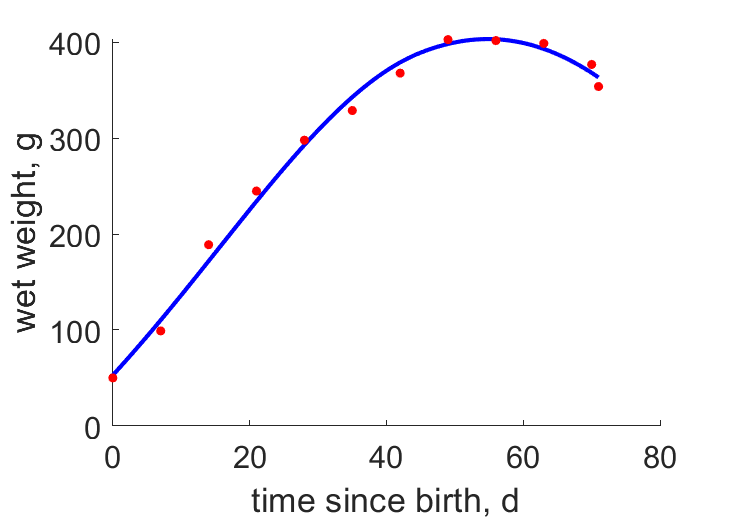Predictions & Data for this entry
| Model: std | climate: MA, MB, MC | migrate: Ml | phylum: |
| COMPLETE = 2.5 | ecozone: MPE | food: biCvf, biCik, biCic | class: |
| MRE = 0.032 | habitat: 0iMc | gender: Dg | order: |
| SMSE = 0.002 | embryo: Tntfm | reprod: O | family: |
Zero-variate data
| Data | Observed | Predicted | (RE) | Unit | Description | Reference |
|---|---|---|---|---|---|---|
| ab | 51 | 48.95 | (0.04014) | d | age at birth | KeitTers2003 |
| tx | 70 | 69.81 | (0.00278) | d | time since birth at fledging | KeitTers2003 |
| tp | 210 | 227 | (0.08096) | d | time since birth at puberty | guess |
| tR | 1825 | 1825 | ( 0) | d | time since birth at 1st brood | AnAge |
| am | 1.858e+04 | 1.86e+04 | (0.000918) | d | life span | AnAge |
| Wwb | 50 | 52.85 | (0.05702) | g | wet weight at birth | KeitTers2003 |
| Wwi | 540 | 513.4 | (0.04926) | g | ultimate wet weight | KeitTers2003 |
| Ri | 0.00274 | 0.002814 | (0.02713) | #/d | maximum reprod rate | KeitTers2003 |
Uni- and bivariate data
| Data | Figure | Independent variable | Dependent variable | (RE) | Reference |
|---|---|---|---|---|---|
| tW |  | time since birth | wet weight | (0.02903) | KeitTers2003 |
Pseudo-data at Tref = 20°C
| Data | Generalised animal | Puffinus opisthomelas | Unit | Description |
|---|---|---|---|---|
| v | 0.02 | 0.02123 | cm/d | energy conductance |
| p_M | 18 | 525.3 | J/d.cm^3 | vol-spec som maint |
| k_J | 0.002 | 0.02121 | 1/d | maturity maint rate coefficient |
| k | 0.3 | 0.2958 | - | maintenance ratio |
| kap | 0.8 | 0.8607 | - | allocation fraction to soma |
| kap_G | 0.8 | 0.7997 | - | growth efficiency |
| kap_R | 0.95 | 0.95 | - | reproduction efficiency |
Discussion
- Feeding is reduced towards end of nestling period
- mod_1: Pseudo-data point k is used, rather than k_J; Data set tp and parameter t_R are added, the latter replacing clutch interval t_N. Postnatal T is based on PrinPres1991, see get_T_Aves. See further the revision page, theme puberty
Acknowledgment
- The creation of this entry was support by the Norwegian Science Council (NFR 255295)
Bibliography